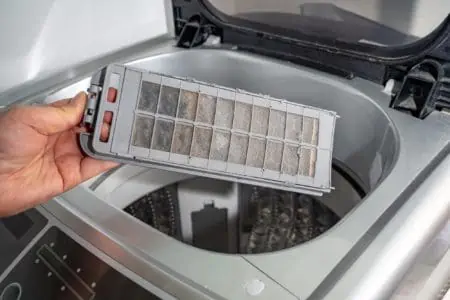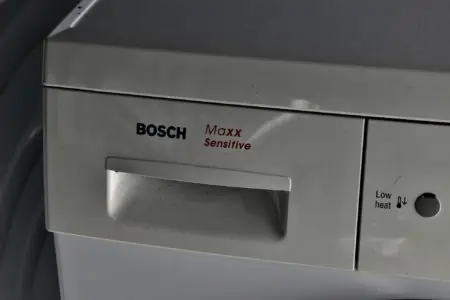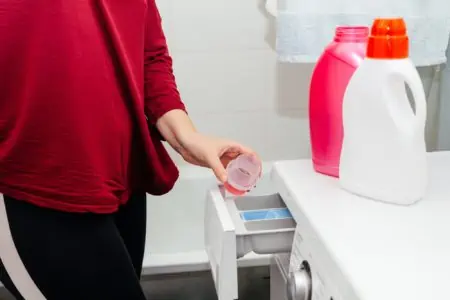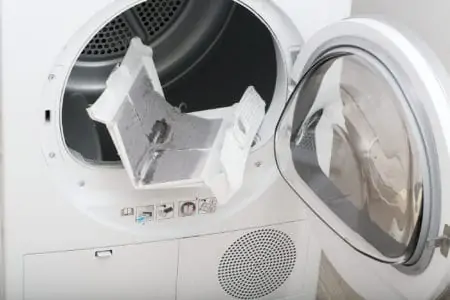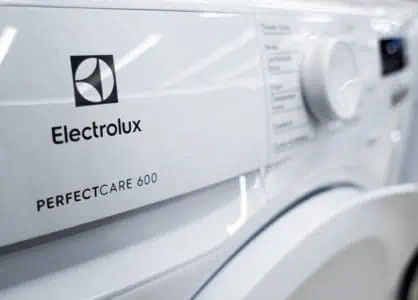If your clothes are coming out of the washing machine stinky and covered with lint, it may be time to clean the filter.
Cleaning the filter every couple of months can also prevent a range of issues with your appliance. This will save you money in the long run.
We’ll show you how to clean a washing machine filter in five easy steps. If your machine doesn’t have a filter, we’ll show you how to clean the water pump where lint might gather.
Key Takeaways
- Clean washing machine filters every 1-2 months to prevent clogs, smelly clothes, and bad drainage.
- Locate your machine’s filter, remove and soak it in warm soapy water for 10 minutes, then scrub with a soft-bristled brush.
- Check the filter area for any remaining lint and wipe with a damp cloth before returning the clean filter to the machine.
- For washing machines without filters, clean the water pump filter every 1-2 months following similar steps.
Where is the Filter In a Washing Machine?
Locating your filter is usually pretty straightforward. The best way to find it is to consult your user manual. But if you need to hunt for it yourself, we’ll share some common places you might find the filter.
On Top Loader Washers
Keep in mind that some top loaders don’t have a filter. Many new models are self-cleaning and do not have a removable lint filter. Instead, they have water pump filters. The location is usually on the bottom right-hand corner of your machine. That being said, some appliances, like those from GE, don’t have an accessible filter at all.
For those that do have a lint filter, try looking around the top rim of the washer tub. You might find a removable screen that gathers lint.
Also, check the top of the center agitator. Many filters are inside these, and you can unscrew and remove them. If your agitator is removable, check the bottom of the agitator.
Other top loader washers house their filter near the water pump or at the end of the drainage hose. You might need to remove the outer housing of the appliance to locate the filter.
On Front Loader Washers
Most front loader washers have a trap door on the bottom right of the machine that houses a lint catcher and water pump filter.
However, some newer models don’t have a removable lint filter since they are self-cleaning.
Do All Washing Machines Have Filters?
You may be wondering the best way to clean a washing machine filter, only to find that your machine doesn’t have one! Many newer models don’t have filters. Instead, they use self-cleaning pumps.
Without removable lint traps, the pump filters remove lint for you. This requires less maintenance from you, but it’s still crucial to clean your machine monthly to remove excess lint build-up.
How Often Should a Washing Machine Filter Be Cleaned
To make it easy, schedule cleaning your washing machine filter every month when you’re cleaning the rest of the machine. That makes it easier to remember.
However, the general advice is to clean your filter every three months. That being said, different manufacturers may have different advice. For instance, LG and Samsung recommend cleaning the washing machine filter monthly.
Experts recommend cleaning a Bosch filter twice a year (1). Other brands, like Whirlpool, don’t advise specific timeframes.
The varied advice can be confusing, but we recommend that you clean your filter every 1-2 months on average.
How to Clean Your Washing Machine Filter
- Time: 20 minutes
- Difficulty: Easy
What You’ll Need:
- Screwdriver
- Towel
- Basin
- Cloth
- Sink or basin
- Hot water
- Liquid detergent
- Soft-bristled brush
1. Locate Your Machine’s Filter
Find the filter. This may vary depending on the brand and whether it’s a front or top loader. Consult your user manual for help.
Once you have found the filter, set up a towel and a basin underneath it. When you remove the filter, it’s normal for water to gush out of the machine. We were surprised by this the first time and ended up with water all over the kitchen floor!
In our experience, a shallow basin or tray works best. For front loader machines, like our Samsung model, there’s not a lot of space between the filter and the floor. So when you remove the filter, you need a shallow basin to catch the water.
You can use a regular-sized basin for top loader machines where the filter might be higher up. If the filter is inside the agitator, you don’t need to lay down a basin and towel.
2. Wipe Filter With a Cloth
Remove the filter.
Before you get to scrubbing the filter clean, gently wipe it with a cloth to remove an excess lint and debris.
3. Soak Filter in Soapy Water
Fill a tub or basin up with hot water. Add a capful of liquid laundry detergent. Soak the filter in the solution for 10 minutes before scrubbing it clean with a soft-bristled brush. Continue until the filter is clean and no gunk remains.
4. Wipe Filter Area
Shine a flashlight in and around the filter area to inspect where lint might be hiding. Use a cloth to remove any excess lint in the area. Dampen the cloth in fresh water and wipe down the filter area.
5. Return Filter
Once the filter is clean, pat it dry and return it to the machine. It doesn’t need to be fully dry since it gets wet anyway.
Make sure it’s securely in place.
6. Run the Appliance
Run the appliance on a short cycle to ensure that there are no leaks and that the filter is securely in place. If not, reinsert it correctly. Once you’re sure it’s in the right place, you can go back to using your machine as usual.
How to Clean Water Pump Filter
- Time: 20 minutes
- Difficulty: Easy
What You’ll Need:
- Towel
- Basin
- Small bowl
- Cloth
- Basin or sink
- Hot water
- Liquid detergent
- Soft-bristled brush
1. Locate the Pump Filter
Just like with the last method, locate the pump filter. This is usually behind a small door at the bottom right of your machine. Consult your user manual if you’re unsure.
Once you’ve located the filter, set up a towel and a small bowl underneath it. First, we’ll be emptying the emergency drain filter but have a shallow basin nearby for when we empty the main pump filter.
2. Empty Emergency Drain Filter
You’ll notice a small rubber hose. This is called an emergency drain filter. Pull it out of place, aim it into the bowl, and remove the cap. Water will slowly fill into the bowl. If the bowl fills up, replace the cap, empty the bowl and repeat until the water stops flowing.
When done, replace the cap and push the filter back into place.
3. Remove Pump Filter
Swap the small bowl out for your shallow basin. Position it under the pump filter, so that it catches the water. Carefully remove the pump filter and let the water run out into the shallow basin. Some of it might miss, but that’s why you’ve laid a towel down.
You’ll maybe notice debris falling out the drain or attached to the filter. Collect it and toss it in the trash (unless it’s valuable, of course!).
4. Soak and Clean the Filter
Fill a basin or sink up with hot water. Add a capful of liquid laundry detergent and soak the filter for 10 minutes before scrubbing it with a soft-bristled brush. Continue until the filter is visibly clean.
5. Inspect and Clean Filter Area
Grab a flashlight and look in and around the drain pump. If you can see a clog, it’s essential to remove it before replacing the filter.
Wipe the surrounding area with a damp cloth.
6. Check Your Septic System
If your washing machine is connected to a septic tank system, lint goes from your appliance into the tank. Over time, this can cause clogs.
To prevent this, you can install external lint filters on your machine. If this would benefit you, remember to clean those filters every month.
7. Return the Filter to the Machine
Once the filter is clean and you’re sure that you have removed all of the clogs, return the filter to the machine. Make sure that it’s secure, and run a quick wash. If there are no leaks, your machine is good to use again.
FAQs
Fresh Filters
Cleaning your washing machine filter is a quick, easy, but crucial task. It will keep your machine running in excellent condition. The best thing about it is: a clean machine equals clean clothes!
We recommend cleaning your lint and drain pump filter every 1-2 months to prevent clogs, smelly clothes, and bad drainage.
